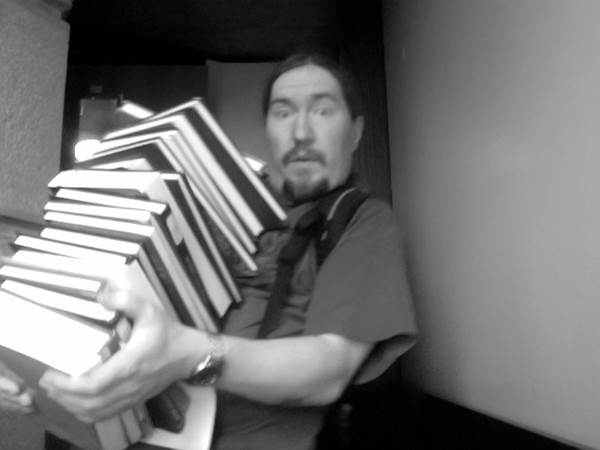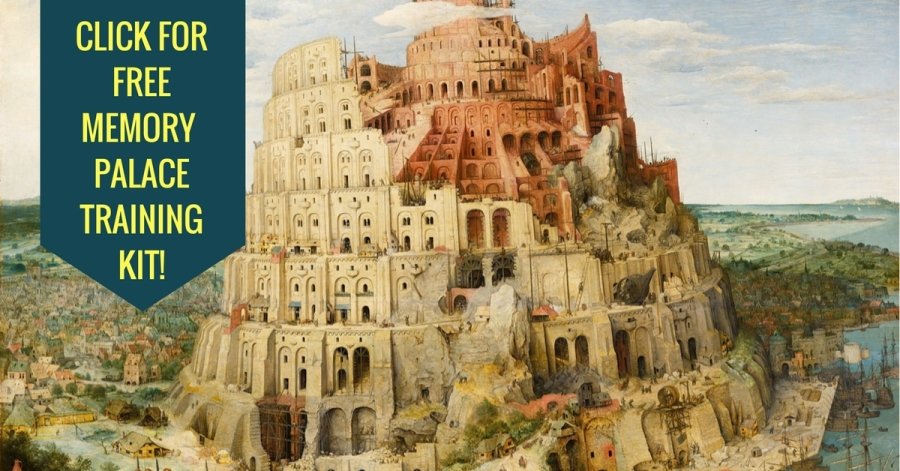Tue, 29 September 2015
You know what it’s like struggling to come up with mnemonics. It can feel a bit like pulling nails out of dead wood with a pair of rusted tweezers. And what really makes the pain so bad is that you know that your brain is teeming with ideas. Great ideas … If only you could catch them. Here’s the good news. In this unconventional brain training post I’m going to teach you how …
You Can Catch More Great Ideas Than The Most Successful Fishing Fleet In The World (Catches Fish)!
Just pick and choose from these super simple brain training activities and start with the most appealing. We’re going to go deep into each one so that you’ll have the fullest possible understanding. Add one or more per month over a year’s time and you’ll enjoy an overflow of ideas so powerful it will take ten lifetimes and thousands of employees to handle them.
Just Kidding – Most Will Be …
Crap. Seriously. As awesome as having boatloads of ideas can be, the real power comes from the refinement brain training brings. We’ll talk about that too a bit further on so your ideas will always come out shining. But here’s the important thing for now: You can’t refine what you don’t have. And you can’t get more ideas to refine if you aren’t already producing a lot of ideas in the first place. That’s why you need an unending flow of ideas that you can turn on at will and focus into form with laser intensity whenever you choose. Here are 3 unconventional ways how brain training can make that happen.
1. Milk Your Mind For Ideas Each And Every Morning
Most people flush their most vibrant ideas down the toilet as soon as their feet hit the floor. It’s true. By the time you hit the head, you’ve forgotten most, if not all, of a valuable stream (pun intended) of ideas you’ll never get back. I’m talking about your dreams. Of course, most of what we dream makes little sense, at least not without practicing the art of dream recall. Even then, dreams remain fundamentally surreal and devoid of fixed meaning. But just because they may be meaningless, doesn’t mean your dreams can’t help you create meaning. Au Contraire!
Since the early beginnings of literature, for example, Daniel in the Bible, making dreams meaningful has been a practice powerful enough to direct the choices of kings. And with The Interpretation Of Dreams, Freud created an entire industry by empowering people to interpret their dreams and generate ideas about what to do and how to live in the world. You don’t have to use the dreams you remember to influence world leaders or deal with childhood trauma. You can simply jot down what you remember and then free-associate to the images and vignettes. Here’s a quick way to get started with this form of brain training: 1. Get a dream journal and pen/pencil. Make it exclusive to your dream capture practice. 2. Place the journal where it’s impossible to miss near your bed. You can even date it before you go to sleep and leave it open at the page you’ll write on. 3. Make the commitment to remembering your dreams. Just say your personal version of, “I remember my dreams. I write them down.” That mantra in itself will serve as powerful brain training. 4. Free-associate to one or more of your dreams. It helps if you get relaxed first. Let ideas come to mind and jot them down. Don’t think about it or try to guide them. Let them breathe. If you recall no dreams …
No. Big. Deal.
Write down, “no dreams” and perhaps a few notes about how you slept. Before you know it, you will start remembering your dreams with depth and intensity. And when you practice associating with these dreams, you’ll always be able to come up with new ideas. The best part is that you’re journaling your dreams. This brain training practice means that you don’t have to associate only with recent dreams for new ideas. You can go back through those pages for as long as you’ve been journaling. You’ll have a treasure trove of images, narrative snippets, and longer sequences as often as you please and always find some new angle on the material. To give you an example, years ago I dreamed about the pyramids. I saw them filled with a scented lava that poured down the sides, creating a river. When I finally got to visit Egypt, for some reason, I remembered the dream and started to explore it for ideas. I was there to research ancient Egyptian culture for its relationship to memory and reincarnation, past lives, etc. That was all fine and dandy and I learned some great stuff in some of the museums I’ll be telling you about soon. But the fact that I remembered this dream and the lava was scented led me to think about aromas, and I wound up wondering if there is a relationship between scent and memory. It turns out there is. I have found a wealth of research material on the matter, much of which centers on the use of oils in mummification – one of the most memory-centered activities in all of history. Would I have thought to connect scent and memory without this dream that helped product it? Maybe yes. Maybe no. But the point is that without the practice of dream journaling as a form of brain training, I probably never would have thought about scent and memory in the context of mummification and essential oils in Ancient Egypt. Deliberately remembering your dreams is a way of engineering happy accidents and generating new ideas that come power packed with resonating value. It’s easy, fun, quick and easy to do. It creates long term value and can change your life in many other ways too.
2. Brain Training Pulls Ideas Out Of Thin Air |
Tue, 29 September 2015
What if I wanted to memorize a chapter in a textbook so I could ace a test on that subject? That would be cool, wouldn’t it? Good news: It’s 100% possible. No JokeWhen I was studying for my doctoral examinations and later for my dissertation defense (rigorous 2 hr. + grilling sessions in front of a committee of 4-7 accomplished professors), I read a total of over 500 books and articles. I’m not kidding. I almost broke my back at the library on several occasions!
Here’s exactly how I used to operate – and still do when I’m conducting research or just want to memorize the contents of a book using memory techniques. It’s an ongoing memory improvement project to continue learning from textbooks and it all begins with this important step every time:
Leave Your Fear At The Door: |
Thu, 24 September 2015
|
Wed, 16 September 2015
… started to love it? Or have you seen a movie that thrilled you, only to find that your opinion suddenly sours? If so, then it could be that …
Someone Is Seriously Messing With Your Memory!
And there’s bad news. The people involved in changing how you feel about products and media you’ve consumed hold more than one weapon of memory destruction. Let’s look at just one of the ways advertisers manipulate your memory. But please understand that I am in no way talking about subliminal advertising. The tools we’ll explore rely solely on images and procedures that rehearse, train and retrain how you think by accessing your memory in particular ways. One tool, for example, involves …
Blatant And Phoney Misinformation About The Competitors
Do you remember the Pepsi Taste Challenge? How thinly they disguised the fact that they were testing Coca Cola with the poor citizens they ambushed on the streets with Coca-Cola? How Pepsi used to call Coke, “the leading cola?” By representing their main competitor in these challenges by association, Pepsi was capitalizing on the fact that human memory is constructed. Our memories don’t come from one location in the brain, but several. This means that as our memories come to the fore, they can be changed by the catalyst responsible for summoning them. And because the advertisements make use of nostalgic images, rousing music and cleverly placed sound effects that also invoke nostalgia (the sound of a soda can being cracked open or bubbling pop snapping against ice), they create feelings. These feelings cause your brain to associate positive experiences with the product and negative feelings with the competition. Because as this documentary reveals, it’s not about selling a product. It’s about selling an idea: At least, that’s the theory. Scientists and marketers call this effect “memory blending.” At its highest level, the injection of blended memories into your mind makes you think that you’re the one who formed your preferences. And if advertising can change how you feel about something you’ve purchased in the past, you can be led to buy more and …
… Think It Was Your Idea!
Soda companies aren’t the only ones to use product comparison and misinformation to create blended memories. Many companies do, including airlines, stereo and speaker manufacturers and fashion designers. The craziest part of all is that in so many cases, the difference between the products is marginal to none. If information is to be perceived by consumers …
It Must Be Done By Advertising
And because what matters most in these advertisement campaigns rely on how we feel about past experiences, advertisers constantly make references to childhood experiences. Playing with toys, camping in the woods, munching on cereal. You might see a mother with a child, a doctor with a patient or athletes with their trainers. Or the ads may feature running on the beach, playing tennis or eating in a restaurant. These iconic, universal cues apply to almost everyone living in the West. Even when traveling in countries like Egypt, I have seen ads nearly indistinguishable from those we see in North America and England.
Two Routes To Radical Memory Change
Let’s look deeper at how all of this memory change works. As we’ve already discussed with the Pepsi Taste Challenge example, the ads work at altering your subjective experiences if the past. Secondly, the ads change how you think about an objective experience from your past. Many ads, especially the Pepsi challenge, blend the two together. To take another example, let’s look at an interesting experiment conducted by Kathryn Brown and reported upon in 1997. In the experiment —- demonstrated that consumers will take second-hand information and use it to reconstruct memories of past experiences. They will do this completely outside of conscious experience. Here are the basics of the experiment: 2o female and 30 undergrads at a university in Iowa were shown the trailer for a Johnny Depp movie called Nick of Time. https://youtu.be/3ylx6aTM2hU The researcher chose this movie because: 1. The plot and marketing were shaped to appeal to Generation X. 2. The movie had not been released in Iowa, reducing the likelihood that students were aware of it. After viewing the film, the researcher asked the students to give their opinion of the film. They were asked to rate the trailer on traits such as acting, directing, pacing, etc. Brown also asked the participants if they would like to see the film in the future. The researcher then thanked the participants for their time after a twenty minute period given for watching and rating the film. For all intents and purposes, the participants thought the experiment was over. Next, however, the students were given reviews of the film to read. Although the reviews were professionally written, students were not given the names of the reviewers or the names of the newspapers or magazines from which the reviews were taken. Students, for example, might have a positive association with Rolling Stone magazine that could influence the experiment. The reviews given to the students were either thumbs-up with 5 stars or thumbs-down with 0 stars. After reading the reviews, the students were given a surprise memory test. The test asked them to reevaluate the movie trailer and then talk about how much they felt the reviews affected them. Although it was an option to say that they couldn’t remember their previous evaluation, less than a measurable percentage took this option. As a result, students who received the positive reviews shifted to more positive evaluations the second time around. Likewise, students who received the negative reviews downgraded their opinion of the film. Overall, when questioned, most participants believed: 1. That they had been consistent with their original evaluation. 2. Their original evaluation had not been affected by the second-hand information. The results of the experiment suggest one thing:
Your Memory Of Opinions You Once Held Can Be Eradicated!
Not only that, but in addition to changing your thoughts about past opinion, your future choices can be altered too. Those who said they would like to see the film based on the trailer but were given negative reviews tended to change their mind. And we’ve probably all had this experience. I remember being very excited to see Jupiter Rising after watching the trailer at the Sony Center Cinema in Berlin. But the reviews completely decimated that desire and to this day, I’ll never really know whether I might have liked the movie or not until I maybe one day watch it. All this said, there’s one big fat white elephant in the room …
Is This Experiment Valid?
It seems so, but we need to question: * The likelihood that they would not have seen the trailer on a national TV station. They do not appear to have been quizzed about their television viewing habits. * They were university students, so we can assume that at least some of them came from another state. We do not know when they might last have traveled to another state. * When people can’t properly remember their previous opinions, how can we trust them to remember whether or not they’ve seen a movie trailer before, let alone the entire movie? Nonetheless, as worthy as these considerations are, I don’t think these problems affect the experiment too deeply. But everything we learned about today does raise one very important question …
Is Selling Evil?
One of the world’s most successful marketing “gurus,” Dan Kennedy, often says that people selling products need to come to grips with one essential fact: Marketing is always manipulation. However, the extent to which manipulation to buy through the use of product comparisons, nostalgia and reviews is unethical or even insidious has much more to do with the product than the marketing. Joe Polish sums it up best when he said in a video that … And so if the product is crap – and let’s face it, soda pop does rot your body – then the marketing of the product may well seem to be evil. But if the product is awesome and makes your life better, than you may have had that experience of saying, “I’m glad I saw that ad.” And in fact, here at the Magnetic Memory Method Headquarters in Berlin, hardly a day goes past when I don’t get an email that starts something like, “thank god I found you.” So even if the quality of products may differ, the tools of effective marketing – the written ads, radio jingles and video presentations that get you itching to buy …
These Tools Of Unabashed Manipulation Are Exactly The Same!
And so at the end of the day, you’re truly on your own. You can do nothing more than decide for yourself. And that’s why guarantees are so essential in today’s world. Whether it’s Amazon’s 7-day return policy or the Magnetic Memory Method 1-year guarantee, not trying items is that interest you is relatively risk-free in today’s world. Just don’t be a jerk and ask for a refund when you’ve used a product and gotten value from it. In the words of the Fonz and one of my favorite marketing mentors (Frank Kern) … Always. Cool. And if you’d like to grab my four free video series and Memory Improvement Kit, then you’re more than willing to do that. I promise, I’ll improve your memory, not bend it. And once you’ve done that, I guarantee that between now and the next time we meet, it will be easy-peasy for you to keep your memory 100% Magnetic. The post The Darkside And The Brightside Of How Marketers Manipulate Your Memory Every Single Day appeared first on Magnetic Memory Method - How to Memorize With A Memory Palace.
Direct download: The_Darkside_And_The_Brightside_Of_How_Marketers_Manipulate_Your_Memory_Every_Single_Day.mp3
Category:Podcast -- posted at: 4:26am EDT |
Thu, 10 September 2015
Whereas we often use the word “memory” as if it’s a singular, globular entity, memory is more than one thing. It’s a collection a multiple entities that deal with different kinds of information, even …
Information About Things That Haven’t Happened Yet!
First we have, prospective memory. Prospective memory is that wonderful device that helps you remember tasks you need to complete and events you’re booked to attend in the future. The only problem is … … prospective memory isn’t necessarily all that good. For example, how many times have you forgotten an appointment, to take a pill, to wash the shampoo from your hair? These slips happen, but even more interesting is how prospective memory tends to fail us most in areas that it should be the most reliable. I’m talking now about routinized tasks. For example, most of us do our own shopping. And yet, why is it that we so often forget items we need and know we need? Even pilots have this problem. Without checklists, even the most routine – and absolutely necessary operations for flight safety – would be forgotten as easily as you can forget eggs or milk.
Spend One Dollar And Benefit From This Memory Exercise Forever
For prospective memory to work, you also need retrospective memory. Retrospective memory helps you recall information that you learned in the past. Your home address, directions to a restaurant or where you put your medication all rely on your ability to recall where things are located in space. Without this kind memory, even if you do remember to take your pills, you won’t have a clue where they are. Prospective memory and retrospective memory work together, and it’s quite easy to keep them fit. Here’s a fun exercise: Go to a dollar store and buy an object. It could be a ball, a pack of clown stickers or hair elastics. Next, visit a friend and ask them to let you hide the object in the back of a closet or somewhere deep beneath a bathroom sink. The more of the home you must navigate to reach the object, the better. In other words, don’t put your object in the hallway closet directly inside the entrance. Put it down in that creepy basement bathroom where a hole in the wall exposes all those rusty pipes. Then make an appointment to come the next day, the next week or even the next month to reclaim the object. When you get home, replay the entire journey in your mind. See the entire path from your home to the store to the creepy basement in your friend’s home. At the same time, see the object you placed in the home and nourish that image. Make it big, bright and colorful. Infuse it with a crazy energy, almost to the point of bursting. Then, use the Major Method in combination with Dr. Jim Samuels‘ method for memorizing appointments and associate the object with the date and time of the appointment you made for pickup. To complete the exercise, keep your appointment and claim your object. Then go hide it somewhere else and repeat the exercise as often as you like. Sounds crazy, doesn’t it? Not really. It’s the way you use to exercise your memory as a kid, after all. Only back then, you called it a treasure hunt.
And Now For Another Episode Of The You Show On The Brain Channel
Having gone to the store and the secret hiding place, you now have a nice little story in your head. Your ability to recall that story is called episodic memory. Always connected to time, episodic memory makes it possible for you to recall elements of your last vacation, going to the movies and just about any expanse of experience that features a beginning, middle and end. Then there’s semantic memory. This kind of memory trades in general facts that aren’t bound with time (as such). Vancouver, for example, is a city in British Columbia, one of several provinces in Canada. Of course, if you’re a historian and can rattle off the dates of when Vancouver was founded and when British Columbia became a province, then you might be blending in a touch of imaginary episodic memory, For example, when I think of places like Vancouver becoming a city, a little flash of story enters my mind. I see stiff European dudes with quills and parchment tricking the Natives into giving up all that precious territory for a few bottles of whiskey and a stack of shiny dimes. To take a more practical example, if you know that Vancouver is in British Columbia, Canada and Seattle is in the American state of Washington, and you’re also aware of the fact that a ferry runs between them … … you can take the ferry and then use episodic memory to recall all the beauty you saw along the way. But here’s the weird thing …
Episodic Memories And Semantic Memories Are Stored In Two Completely Different Parts Of Your Brain!
Do you remember that interview on the Magnetic Memory Method podcast with Dr. Gary Small? In that interview, he told us that our memories go into different neighborhoods of the brain. In those neighborhoods are tiny little houses in which parts of memories live. In order to simultaneously remember facts about places and episodes of time that you may have experienced, your memories have to leave their respective neighborhoods and come together in yet another part of your brain. It’s like having a family reunion where everyone comes in from different cities to eat at Recall Restaurant on the tip of your tongue. (link to tip of tongue podcast) And last but not least, there’s a very strange kind of memory, a kind of memory that often …
Doesn’t Require Your Conscious Awareness!
We fall this mysterious form of recall “procedural memory.” Some experts disagree whether it is a kind of memory all on its own, or a subset of semantic memory. I don’t know about you, but the ability to ride a bike without thinking about it seems quite different than the semantic knowledge of how and why bicycles work as they do. The same thing goes for guitar. Knowledge of where to find notes on the fretboard and how to form chords requires a different kind of memory than the procedural memory that takes over when some maestro is ripping it up on the stage. Of course, even though procedural memory can be accessed without conscious awareness, episodic memory can intervene. For example, your mind can wander during rehearsal or performance, breaking the flow of the song and causing you to mess up. Likewise, bike riding on autopilot while daydreaming can cause you to sail through a stop light or crash into another cyclist. And then these too become episodic memories. Like, for example, the time I was hit by a car crossing an intersection on my bike and how vomited into my mouth the last time I performed on stage because my joint pain had gotten so bad.
Fun Stuff All This Memory Business, Isn’t It!
It sure is. And now that you know about these different kinds of memory, you are truly empowered. You can exercise each of these special memory types and improve them. And if you use the Magnetic Memory Method, you can probably already see exactly how my unique approach to encoding, storing and recalling information lets you harness the power of each kind of memory you’ve just learned about. But if you don’t know about the Magnetic Memory Method, why then now is your chance to avail yourself of my special Memory Improvement Kit and 4 FREE video series. Grab hold of the magic of these truly special memory techniques right here. And until next time … Keep Magnetic! The post These 5 Kinds Of Memory Make The World Awesome appeared first on Magnetic Memory Method - How to Memorize With A Memory Palace.
Direct download: These_5_Kinds_Of_Memory_Make_The_World_Awesome.mp3
Category:Podcast -- posted at: 2:15am EDT |
Wed, 2 September 2015
… almost on auto-pilot? Here’s the good news: Even if you don’t use elaborate memory techniques and mnemonics, the following 5 ways will help you improve your memory almost without effort.
1. When Darkness Falls …
Go to sleep with the sun. Seriously. What have you got to do after dark anyway? Netflix? How boring. Drinking in bars? How destructive to your memory. Playing Scrabble? Well … okay. That’s at least halfway good for your brain. But the reality is that we’re killing our memory by stating up late and waking up early. And when you kill your memory, you murder something else too:
You Murder Your Intelligence!
And as with all acts of murder, you will get caught and you will be sentenced to life in the prison of stupidity and forgetfulness. Mark my word. Next to getting more sleep, it’s essential to …
2. Keep Your Brain Moist As The Soil Of A Mighty Rain Forest
That’s a fancy way of saying, drink lots of water. All too often we forget to imbibe the world’s mightiest drink. Oddly enough, some people don’t even like it. This strange, but true fact is responsible for forgetfulness around the world. But it doesn’t have to be you. And if for any reason you struggle to remember to drink deep from the tap in your kitchen, the solution is simple enough. You can create a visual mnemonic by placing a big fat bottle of water on your desk. Or you can print out a picture of a bottle of water and stick it on the wall or window directly behind your computer. In addition to this …
Use Every Bit Of Technology You’ve Got To Remind You
Smart phones … Dumb phones … Computer calendars … All of these of these come equipped with programmable alerts. Most of them can be set to repeat every hour on autopilot. It’s easy enough to ignore these alerts, however, so it helps to get theatrical. Instead of “drink water,” program in something like:
Drink Water Or Else All The Cats On YouTube Will Suffer One Thousand And Seven Deaths!
If that doesn’t get your attention, I’m not sure what else will. Well … maybe this:
3. Funnel Words Into Your Mind Like The Wind Shapes The Desert
One of the beautiful things about living in Berlin is that they still have bookstores all over the place. Not only that, but you still see people reading books too. Here’s a quick guide on how to read a book: Buy a book. No, it doesn’t have to be a book by me. Whatever you read, by all means read on Kindle or some other digital reader, but I recommend also holding a physical book in your hands once in a while. As this article suggests reading books instead of Kindles can improve your memory, concentration and good looks. Reading in general helps improve your memory because you hold the details of a story in your memory over an extended period of time. You also retain and maintain details about characters, objects and locations. But you can also deliberately memorize elements of the books read by using memory techniques. For example, instead of relying on bookmarks or dog-earing pages, you can memorize the number of the last page you read before pausing. This provides you with delightful memory exercise. Speaking of which …
4. Get Your Fat Butt Into Gear
Exercise is one of the best ways to improve your memory. It sends oxygen rich blood to your brain and brings fitness to your entire body. Awesome, right? You can also use your exercise time to reminisce over the books you’ve been reading. If you’re not a reader, you can play movies you’ve seen beginning to end in your mind (link to breaking bad movie post). And if you use Memory Palaces (you do use Memory Palaces, don’t you?), then what better time to practice Recall Rehearsal than when you’re out and about, huffing and puffing and sweating up a storm? Exercise also improves your mood, and when you use memory techniques, your mood improves even more. Nothing feels better than combining jogger’s high (wiki link) with the edification of recalling foreign language vocabulary. Or mathematical equations, song lyrics, professional terminology, or whatever else wets your whistle.
5. Stop Rolling Like A Stone And Gather A Bit Of Moss For Once In Your Life
Meditation makes everything in life better, including your memory. The problem is … most people have been misled by weird definitions. For example, many people think that they’re supposed to sit like a stone. And like a stone, they’re not supposed to have thoughts. No, dear Memorizers. No, no and a thousand times no. As the great Alan Watts pointed out …
Sitting Like A Rock Is Boring, Useless And An Utter Waste Of Time!
Instead of eradicating thoughts from your mind (which is technically impossible), don’t bother doing anything with them. Watts most famously said that the best way to practice meditation is to sit just to sit. Don’t “try” to do anything. Just sit there on the floor. Let your mind wander. Be mindless as you sit and float around in fantasies about the future, alternate versions of the present and strange wishes about an alternate version of the past. Maybe not the first time, but eventually you’ll wake up from the mindless fantasies that have your mind the vice of your grip. It’ll go something like this. When you’re sitting there, all of a sudden you’ll say …
Holy Moley! I’ve Been Sitting Here On The Floor Lost In Thought And Didn’t Even Realize It!
Nothing will prepare you for the enlightenment that follows. It might not last for long, but the edification you feel will stay with you and bring a completely new shape to the contours of your day. Not only that, but the experience will be hard to forget. And then the more you meditate, the more you’ll remember that you’re seated on the floor, sitting just to sit. Your periods of mindfulness will lengthen and you’ll take these levels of awareness deeper and longer into your days. And the more mindful you are throughout the day, the more you’ll pay attention. And the more attention you pay, the more naturally and effortlessly you’ll remember the events and facts you experience as you go through life.
How To Be A Memory Scientist In The Laboratory Of Your Mind
You’ve now had just a taste of some of the ways you can increase your memory by barely lifting anything heavier than a book or a bottle of water. In the case of sleeping more and practicing meditation, you don’t have to lift anything at all. Go ahead and give these few simple techniques a try. Keep a memory journal as you experiment so you can analyze the results. By measuring what you’re doing and when you’re doing it, you can create a picture of your daily life and how your memory serves you throughout. And analyze every Memory Palace you create. By taking time to go through them, you’ll deepen your familiarity with each and every one. Memory Palace work, even without memorizing anything, is great mental exercise. But …
The Easiest Way To Experience Massive Memory Improvement Is …
… do daily memory drills. An easy and compact way to do this involves a tiny set of objects known as playing cards. All you need to do is mix them up and use the Magnetic Memory Method to memorize them in ever knew arrays of random order. And if you want to learn how to do that, then I invite you to join the Magnetic Memory Method Masterclass. But start by grabbing my Free Memory Improvement Kit in order to make sure that the Masterclass really is something for you. If the Masterclass is something for you, then I want you to join it. If the Masterclass isn’t something for you, then I don’t want you to join it. Nothing could be simpler than that, dear Memorizer. And so until we touch base again, never forget to keep yourself well-rested, well-hydrated, well-read, fit and fully meditated. Oh, and of course, always … Always … Always keep Magnetic. Further Resources The Amazing Doctor Who Wanted To Cure His Patients By Memorizing A Deck Of Cards The post The Five-Fold Path To Memory Improvement appeared first on Magnetic Memory Method - How to Memorize With A Memory Palace. |
The Magnetic Memory Method Podcast

Categories
generalMemory Improvement Tools
Memory Method Tips
Brain Exercises for Memory Improvement
Memory Improvement Case Studies
Podcast
Guest Post
Memory Palace Tactics
Practical Memory Techniques
Uncategorized
Improve Memory Q&A
Archives
AprilMarch
February
January
December
November
October
September
August
July
June
May
April
March
February
January
December
November
October
September
August
July
June
May
April
March
February
January
December
November
October
September
August
July
June
May
April
March
February
January
December
November
October
September
August
July
June
May
April
March
February
January
December
November
October
September
August
June
May
April
March
February
January
December
November
October
September
August
July
June
May
April
March
February
January
December
November
October
September
August
July
June
May
April
March
February
January
December
November
October
September
August
July
June
May
April
March
February
January
December
November
October
September
August
July
June
May
April
March
February
January
December
November
October
September
August
July
June
May
April
March
February
January
December
November
September
| S | M | T | W | T | F | S |
|---|---|---|---|---|---|---|
| 1 | 2 | 3 | 4 | 5 | ||
| 6 | 7 | 8 | 9 | 10 | 11 | 12 |
| 13 | 14 | 15 | 16 | 17 | 18 | 19 |
| 20 | 21 | 22 | 23 | 24 | 25 | 26 |
| 27 | 28 | 29 | 30 | |||
Syndication

 Do you get overwhelmed and frustrated every time you need to come up with new ideas when using memory techniques as part of your brain training? Especially when learning a
Do you get overwhelmed and frustrated every time you need to come up with new ideas when using memory techniques as part of your brain training? Especially when learning a 


 Here’s a great question about how to memorize textbooks I received from a Magnetic Memory Method fan:
Here’s a great question about how to memorize textbooks I received from a Magnetic Memory Method fan:




 This Man Shows You How To Unlock The Extreme Power Of Your Memory
This Man Shows You How To Unlock The Extreme Power Of Your Memory Have you ever purchased something and hated it? And yet, for some reason, you gradually …
Have you ever purchased something and hated it? And yet, for some reason, you gradually …
 Memory is not what you think it is.
Memory is not what you think it is. Wouldn’t it be great if you could experience memory improvement …
Wouldn’t it be great if you could experience memory improvement …